(PART 1 of a 4 Part Report)
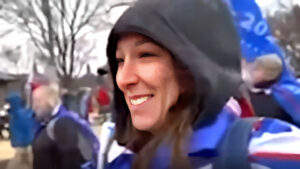
As the smiling, exuberant former Air Force veteran marched to the Capitol from the White House on January 6, 2021 to protest the national vote confirming Joe Biden as the 46th President of the United States, little did Ashli Babbitt know when she took this self-video that she had begun the last hour of her life.
The only person shot and killed by police during the infamous riot at the Capitol was a 5’2″ 110 lb. unarmed woman who died shortly after physically trying to stop one of the day’s most violent rioters.
Her execution apparently wasn’t sufficient for the Department of Justice and police investigators. In order to provide some justification for the shooting, they had to portray her as one of the violent protesters who ultimately got what she deserved. Her reputation had to be destroyed as well.
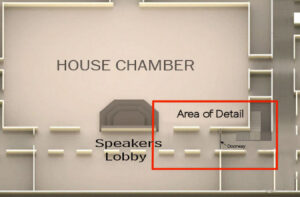
Ashli Babbitt was fatally shot by United States Capitol Police (USCP) Lieutenant Michael Byrd as she inexplicably attempted to crawl through a broken out windowpane in a doorway entrance to the “Speakers Lobby,” a hallway and room just off the House Chamber.
As I wrote in TheAmericanCitizen.org in July 2021:
“Capitol Police are under “The Use-of-Force Continuum” that outlines the specific protocol that officers are required to follow when they deem force is necessary to control a situation.
“…[T]he policy ramps up the degree force needed from: just an officer’s presence — to verbal commands — to empty hand control — to non-lethal options (baton, chemical spray, Tasers, etc.) — to the highest level or lethal force that requires use of a firearm. This final, deadly option must only be used if the subject is deemed a very serious threat to the officer or others.”
A month later in August 2021, the Capitol Police also declared the shooting lawful. Its Office of Professional Responsibility wrote: “An officer may use deadly force only when the officer reasonably believes that action is in the defense of human life, including the officer’s own life, or in the defense of any person in immediate danger of serious physical injury.”
This analysis will look at what took place in that doorway just the last two minutes before the fatal shooting and whether lethal force was indeed justified.
The official investigation deemed it was. But as we shall see, the Department of Justice’s Memorandum declining criminal prosecution of Lt. Byrd is incomplete and misleading. The DOJ stated in its April 2021 report that it could not prove that the shooter “willfully used more force that was reasonably necessary under the circumstances.”
To support this conclusion it had to paint the 12 year, Air Force Security Force (formerly Military Police) veteran as “one of the mob,” leading the charge to physically harm members of Congress.
Had the DOJ truly looked closely at the evidence it would have seen that although she was indeed a protester, Babbitt was clearly against the actions of the “mob” — in fact more so than police at the scene.
Even before the new information was provided, the homicide of Ashli Babbitt has even angered many in law enforcement. To them it was not a “good shoot.” And with the addition of video from independent journalist Tayler Hansen, the official investigation appears suspiciously shoddy — designed to produce a predetermined outcome.
Grievous security errors were made on that eventful day by a number of those in authority including the Mayor of D.C., Muriel Bowser, the U.S. Capitol Police and the House and the Senate Sergeants of Arms. Bowser, for rejecting deployment of the National Guard offered in advance by President Trump, and woefully inadequate preparation and staffing by Capitol police.
With foreknowledge that there would likely be hundreds of thousands of protesters near the Capitol, only slightly more than half of the normal contingent of USCP officers showed up to work on January 6, 2021. 1,214 officers apparently worked that day but incredibly the USCP said it could account for only 417 officers and did not know the whereabouts of the other 797. Some didn’t show up because they were home “teleworking.” Huh?
[Capitol Police were ill prepared in spite of a $464 million budget and 2,000 armed officers. As usual in Washington, D.C., poor performance resulted in more funding. The USCP had its budget increased by $150 million or 32% in 2022. President Biden’s proposed budget for the Capitol Police in 2024 is $841 million, an 81% increase in just four years.]
However, the lack of planning by the USCP and resultant chaos and violence had rare bureaucratic consequences. The three top security chiefs resigned shortly thereafter including Capitol Police Chief Steven Sund, House Sergeant of Arms Paul Irving and Senate Sergeant of Arms Michael Stenger. (In a subsequent interview Sund maintained the USCP were set up to stand alone by denying National Guard assistance that he requested well in advance due to political optics.)
Hansen’s video should have completely changed the accepted narrative about Babbitt. He was in the Capitol on that fateful day and happened to be following Mrs. Babbitt as she approached the doorway to the Speakers Lobby, just a few minutes prior to her death.
Each of the USCP officers who were at the scene where Babbitt was shot (with the exception of the shooter, Lt. Michael Byrd) were eventually interviewed by officers from the Internal Affairs Department (IAD) of the Metropolitan Police Department of Washington, D.C. (MPD).
Combining all available videos along with the MPD interview transcripts and summaries (all F.B.I. interview transcripts were redacted) as produced by Judicial Watch’s FOIA (Freedom of Information Act) request leads to the conclusion that Babbitt and the “mob” that surrounded her had dramatically different goals.
The activity that took place between Babbitt and the mob’s most violent offender, 30 year-old Zachary Alam, in the small area in front of the eastern doorway to the House Speakers Lobby has been either overlooked by the media and law enforcement or, more likely, intentionally ignored.
Ashli Babbitt was there as a protester to be sure but she was not a rioter. She was outraged enough by the destruction caused by some to physically assault the most violent of the protesters and then seemingly try to escape from him and the mob. This extremely relevant act was never mentioned in the DOJ’s final report.
This analysis extensively uses screenshots from available videos to show that Babbitt was disgusted how the destructive behavior of a few was hijacking the intended impact of the original protest.
In fact, of all those who were gathered at the doorway including Capitol police officers, it was only the diminutive Babbitt who three times tried to stop Alam, the lowlife who arrogantly threw himself into police officers while punching and destroying the doorway’s windows. Video evidence shows that she twice tried to push him away from the doors and officers. When he persisted, she finally resorted to actually punching Alam in the face.
In the relatively confined space just outside of the Speaker’s Lobby, it appeared the crowd contained all facets of a typical group of protesters — from those who truly wanted a peaceful demonstration to convey their message, to a small minority who were intent on violence and destruction. As usual it was the violent group’s actions that hijacked and forever tainted the primary objective of the protest.
What this analysis will not do is provide a definitive reason why Babbitt decided, apparently on the spur of the moment, to climb through the open sidelight into the Lobby hallway. This impulsive decision proved to be a fatal mistake.
* * *
Lt. Michael Byrd, Sergeant Paul McKenna and Officer Reggie Tyson along with other USCP officers were assigned to the House Chamber on January 6. All three were dressed in business attire and made their way to the Speakers Lobby as the House members were evacuated out the western doorway.
Though he declined to give a formal statement nor be interviewed by MCD Internal Affairs’ detectives, Lt. Byrd did provide a “voluntary debrief” through his attorney, Mark Schamel.
The interview summary (P.46) from Officer Tyson and the written statement from Schamel mentioned that Tyson and Byrd barricaded the doorway to the Speakers Lobby “as the demonstrators made their way up to the other side of the doors. … Officer Tyson and Lieutenant Byrd then took up positions near the first couple of pillars in the Speaker’s Lobby.”
“While they were barricading the doors, a ‘mob of protestors’ came to the doors, and calls went out over the radio that shots had been fired. Lieutenant Byrd drew his service weapon after the call … (and) took a tactical position behind a wall in the Speaker’s Lobby…” the statement said.
But as the video (and attached screenshot) evidence will reveal, three USCP officers were guarding the doorway after the barricade was put in place and before any protesters arrived.
If Lt. Byrd was already at the doorway when the protesters arrived, why didn’t he inform the three USCP officers who also there before protesters arrived and were clearly visible on the other side of the doorway? The uniformed officers may have been much more assertive with the protesters if they knew that Byrd, McKenna and Tyson literally had their backs?
Why would Lt. Byrd remain hidden behind a pillar a few feet away leaving his fellow USCP officers thinking they were alone and unprotected to face dozens of angry protesters?
Screenshots and Timeline
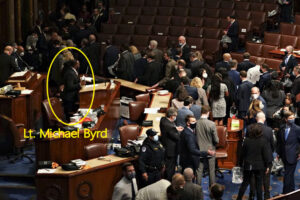
Lt. Michael Byrd, can be seen in this photo directing the evacuation of the House members out the western door of the Speakers Lobby. From here he will move to the eastern doorway of the Speakers Lobby and draw his weapon.
Photo #2. The Speakers Lobby and hallway is the area directly south of the House Chamber. Notice the area outside the Speakers Lobby doorway was relatively tight given its proximity to the neighboring stairway, meaning that there just wasn’t enough room for many dozens of protesters to gather.

(The area of detail was slightly altered from the original Washington Post graphic by The American Citizen.)
[Virtually all the remaining photos in this analysis are actually screenshots from various videos publicly available. Since they were captured from videos in motion, many are somewhat blurry.]
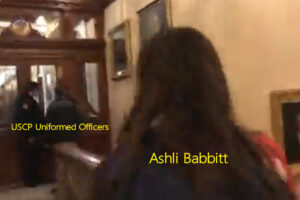
Photo #3. In this photo Ashli Babbitt was seen walking alone and already somewhat agitated according to Tayler Hansen, an independent journalist and videographer who decided to follow her.
Hansen first saw Babbitt as she was walking by herself down a hallway toward the Speakers Lobby doors. Only the three uniformed USCP officers were (visible) there at the time casually talking with each other as shown here in Photo 3. Hansen’s video shows he and Babbitt passed a House Sergeant of Arms employee, Jason Gandolph, on their way to the doorway.
Hansen said Babbitt was friendly with the officers when she first arrived but knew there was an angry group of protesters behind her and immediately told them they would need more assistance. She was very concerned that this group had already hijacked her desired peaceful protest into a violent one.
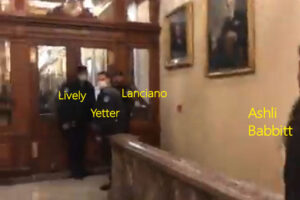
In Photo #4 notice that the three uniformed United States Capitol Police (USCP) officers are alone as Babbitt walks along the railing of the stairway in the confined area in front of the western Speakers Lobby doorway. The doors have already been locked and barricaded from the other side. This is a decent view of the small area where all the activity that will take place.
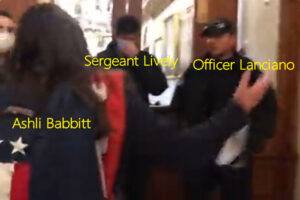
Photo #5 shows the three uniformed USCP officers have taken their positions at the doorway. [The Judicial Watch Freedom of Information Act (FOIA) request later identified them as Officers Kyle Yetter (left) and Christopher Lanciano (right), led by Sergeant Timothy Lively (center)].
According to Hansen, Babbitt is already pleading with the officers to get additional assistance due to the loud and aggressive group coming up behind her.
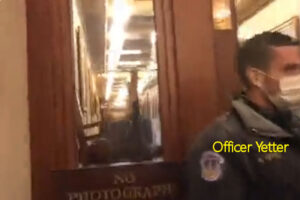
Photo #6 shows Officer Kyle Yetter in front of the doorway with first window broken (southern-most sidelight) shown here still intact.
Officer Tyson was interviewed at 6:04PM on Jan. 6 (p.49). He stated that he and Lt. Byrd took their defensive positions with guns drawn after they barricaded the doorway. He said they were in those positions when the demonstrators began breaking out the glass windowpanes.
This statement has problems. It says, “Demonstrators began breaking out the glass on the doors as well as the windowpanes” which is true but they began this when the uniformed USCP officers were at the doorway and clearly visible.
Why wouldn’t Officer Tyson mention the uniformed officers who were standing either directly in front of the doors or off to the side for the entire time there were demonstrators there – with the exception of just 18 seconds from when the uniformed officers moved away from the northern wall until Babbitt was shot?
And why did they not assist Yetter, Lively and Lanciano who were clearly unprotected in front of the violent protesters? It is highly likely the uniformed officers would have acted more forcefully in protecting the doorway had they known there were three additional armed USCP officers behind them with weapons drawn.
Both Tyson and Byrd say they shouted commands to stay back but in none of their statements did Officers Yetter and Lanciano say they heard any shouts from them. Nor did any protester at the scene mention hearing their warnings nor were any captured on video.
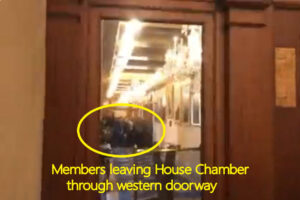
Photo #7. In this screenshot from Hansen’s video the House Members can still be seen leaving the Chamber out the western doorway to the Speakers Lobby.
As we’ll see in Part 2, the violent action is about to begin in this small area in front of the doorway. The lone woman in the crowd will take it upon herself to deal with the most violent of the protesters and attempt in vain to tone down the frenzy of the mob. For these efforts and one inexplicable act, she will be fatally shot with as many as 10 armed USCP officers within 25 feet of her.
Part 2 and 3 will closely look at the tragic last 90 seconds of Ashli Babbitt’s life. It will also examine the inconsistent/contradictory statements by police officers at the scene and seriously question the decision by the Department of Justice not to prosecute Lt. Michael Byrd and the conclusion by the D.C. Metropolitan Police Department that this was a “good shoot” not even worthy of a slap on the wrist.

